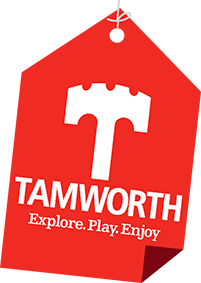History of Tamworth Market
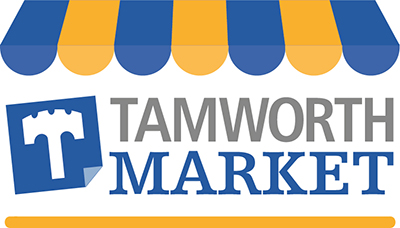 Tamworth market is one of the oldest links to Tamworth’s past, its origins date back over 1,000 years to Anglo-Saxon times.
Tamworth market is one of the oldest links to Tamworth’s past, its origins date back over 1,000 years to Anglo-Saxon times.
Tamworth is unique having been granted a charter to hold 2 markets and its charter would be renewed several times by the ruling sovereignty over the decades to come.
In early days a market was held each Saturday, or rather two markets, back in the day when Tamworth was half in Staffordshire and the other half in Warwickshire.
The Staffordshire market was held near the church. In 1293 a stone cross was erected in what was the market square for Staffordshire, close to the junction of Colehill and Lower Gungate. Today, the Old Stone Cross Pub in Church Street, its name now commemorates the fact that it stands close to the site of the ancient cross.
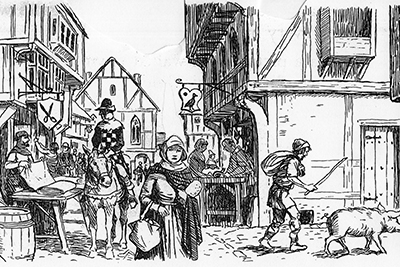 However, the pub was formerly called the ‘Three Tuns Inn’ and the thoroughfare was not always known as Church Street. In medieval times it had two names – the section between St Editha’s and the crossroads (formerly known as Carrefour) was called High Street, whilst the section from the church to Gumpigate (Lower Gungate) was known as Butcher Street, on account of the swine market that was held near the ancient cross.
However, the pub was formerly called the ‘Three Tuns Inn’ and the thoroughfare was not always known as Church Street. In medieval times it had two names – the section between St Editha’s and the crossroads (formerly known as Carrefour) was called High Street, whilst the section from the church to Gumpigate (Lower Gungate) was known as Butcher Street, on account of the swine market that was held near the ancient cross.
The Warwickshire market was held near to the castle entrance. The market has been held in the street which has for centuries been know as Market Street, although the boundaries of the actual market place have varied slightly from time to time.
This peculiar state of affairs of having two markets remained in force until April 1889 when the whole of Tamworth was designated a town of Staffordshire.
Market day was traditionally a time for enjoying a few beers in the local alehouse, the atmosphere often rowdy and boistrous and 2 markets presented ‘Tammies’ with twice the opportunity to let their hair down.
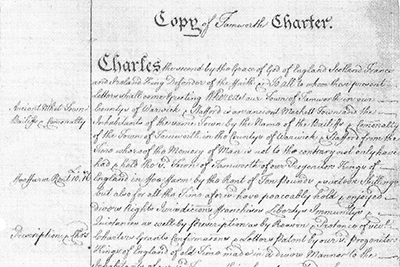
Strangers had to pay for the right to sell goods at these markets where everyone from local farmers’ wives, itinerant traders, pedlars and strange sounding foreigners with just a smattering of the local tongue came together to buy and sell. The market places would be alive with the sounds of clopping horses and rattling carts, littered with the droppings deposited by the horses, cows, etc, and smelling of rotting foodstuffs and stinking sewage.
The Bailiffs and their officers would be supervising the market and collecting stallages and tolls, making sure all traders paid their dues.
Many local people would have baked bread or brewed beer for sale at the market. The officials would check the size, weight and price of the loaves and the quality of the beer. If the town ever ran out of bread, all the bakers were fined.
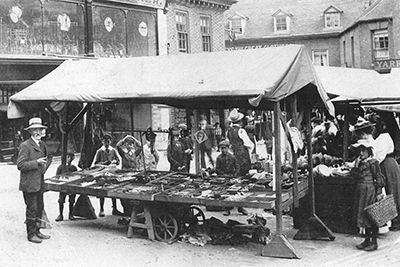
Livestock, cereals, leather, salt (the essential Medieval preservative) cloth and metal work were all sold on the market along with foreign imports. Areas around the open market would have been allotted to specific crafts and trades.
Of particular interest is the huge amount of space given over leather working which reflects its relative dominance in this period.
Local laws and customs governed the market from ancient times, but the first recorded is a fracas between Tamworth traders and ‘men of Lichfield’ who in 1204 declared that unjust tolls had been taken. The following century, the Earl of Warwick was ordered to ‘quiet the dissention between the Bailiffs of Tamworth’ and other towns.

Tamworth Market had thrived by so much, that by 1541 it was noted by the renowned Tudor historian, Leland, that Tamworth had ‘a celebrated market’.
There have always been people on the lookout to make an unfair profit and sometimes a trader would buy up all there was of a commodity so that they could sell it at a higher price. This was called regrating and was totally forbidden.
Many live animals were sold, and a pig market was held in Lichfield Street. With no refrigerators, butchers had to buy live animals to slaughter themselves or the meat would not be fresh. All bulls had to be baited by dogs before they were slaughtered to make the meat tender. The slaughter of animals meant a supply of skins and there was a number of tanners in Tamworth.
Hucksters (Pedlar / Hawker) came from all over the Midlands to sell their wares.
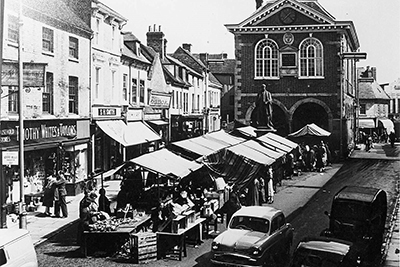
It was common for ‘quacks’ to offer homemade medicines for everything from plague to piles and even pulling out bad teeth for a small fee, while a cheerful trumpet would be played to drown out the patient’s cries.
Crowds meant prosperity and in medieval times the stallage fees charged to strangers to trade in Tamworth brought in enough money to pave the streets.
Ale was only a penny a gallon, chains and tools were made by local smiths, the travelling tinker mended pans and toffee apples were made over open fires.
In 1701 the Town Hall was built by Thomas Guy, the space beneath its huge pillars became known as the ‘butter market’, cheese, butter and eggs would be sold by farmers wives from under the cool arches, while their menfolk bartered over the price and quality of corn in the assize room above.

The town pillory was also kept beneath the Town Hall to punish any persistent market offender along with any other wrongdoer. Stale bread, foul meat, rotting vegetables and rancid tomatoes were plenty and readily available to hurl at any unfortunate clapped in the stocks.
As the town grew and prospered, shops were opened with houses made over them. Pretty soon the river side of Market Street became built up and frequently blocked by traffic. The market would have been lit at night with braziers and then oil lamps and then the Victorians added bright gas flares to light the picturesque scene.

In 1873, Tamworth Cattle Sales Yard opened in Victoria Road which had previously been situated in Church Street, originally known as ‘Butchers Street’ in medieval times on account of the swine market that was held near to the ancient cross.
As the town grew, the market moved around the town from Holloway, along Church Street and even Gungate, anywhere a trader could put up a stall or even halt a laden barrow full of produce from his allotment.
It was 1889 before the whole of Tamworth was designated a town of Staffordshire.
In Edwardian times, Mr J H Johnson, a regular trader, would be seen in his Panama hat selling from his haberdashery stall, always set up at the rear of the Town Hall.
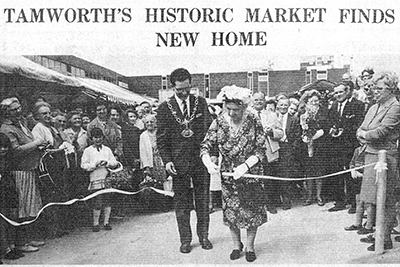
In 1953, Dusty Beesley sold flowers from his stall right beneath the Peel statue.
During the redevelopment of the tow
n in the 1960’s, the market was temporarily held on the Church Street site of demolished Middle Entry. The entrance was via a small narrow opening by the side of the then Clifton Cycle Shop.
Soon the ancient shops opposite Church Street were pulled down, and in 1967, whilst the demolition work was taking place, the market moved to the car park beside the Assembly Rooms in Corporation Street.

The area became known as St Editha’s Square, purposefully designed to be the new market place. At a cost of £8,000, this new market place fronted the new Middle Entry and was opened to the public in June 1970. Edith Kimberley, aged 74, officially cut the ribbon as she was the longest serving stall holder in Tamworth at the time.
Today the market stalls are allowed in the town on Tuesday and Saturday and situated in George St, Market St and St Editha’s Square. The produce may have changed considerably but the market itself remains a weekly reminder of Tamworth’s Anglo-Saxon past – an ancient tradition from the town’s very earliest days.
Historic Market Timeline
1204 – The first records of Tamworth market appear, although probably of earlier origin
1246 – An inquisition is taken which states the town is divided by two counties, Stafford and Warwick of which the King has burgesses of the same status on both sides. Unfortu
nately the rent on the Warwick side was 48 shillings 4 pence whilst the rent on the Stafford side was 50 shillings. The burgesses on the Stafford side give pannage (Pannage is the practice of releasing livestock-pigs in a forest, so that they can feed on fallen acorns, beechmast, chestnuts or other nuts) according to the number of their hogs. The Dean and Cannons of the church receive the issues of the fair but the issues of the market appertain to the king which are plentiful and include fines and other benefits equating to 50 shillings on both the Stafford and Warwick side.
1293 – Old Stone Cross erected on the market square for Staffordshire
1294 – It was ordered that the makers of tripe henceforth do not wash tripe, except by the lord’s bridge (Ladybridge) where it will not be harmful to the town, under pain of 12d
1296 – It was ordered that no one allow strange women (women from outsi
de of the borough) to brew in his house under pain of half a mark and that no one carry his malt to be ground or water for brewing under the same pain.
1297 – The Bull Ring at the junction of George Street, Bolebridge Street and Coleshill first recorded
1304 – First record of town name being spelt as present – Tamworth
1304 – It was ordered under pain of 2s (10p) and the forfeiture of anything found that women who sell the entrails of oxen or other animals shall not henceforth throw out refuse at their doors to the harm and abomination of passers-by
1337 – Edward III made a grant of two fairs, to be held on St George’s Day and St Edwards Day and the four succeeding days
1357 – It was ordered that no brewer sell ale above 1d (5p) a gallon under pain of 12d (6p)
1367 – It was ordered that henceforth no man or women put, or cause to be put, the entrails of oxen upon the pavement, under pain of 3s.4d. (17p)
1368 – Ordered by the assent of the whole township on the part of the county Warwick that no men or women from Wales shall sell ale in Gumpigate (Gungate), under pain of forfeiture of all their ale each time
1371 – Ordered that any butcher putting blood or entrails upon the pavement shall give 6d each time to the Bailiffs
1378 – King Richard II issues a charter
1455 – The Butcher – the east end of Church Street is first mentioned
1465 – The legendary meeting supposedly takes place between King Edward I
V and the ‘Tanner of Tamworth’. An early ballad relates how Edward makes sport of the Tanner who mistakes the King for a highway robber. Edward finally reveals himself and rewards the Tanner who promises ‘If ever thou comest to merrie Tamworth Neates leather shall clout thy shoen’.
1505 – An order was made by the Tamaworth Court Leet – ‘No one from henceforth to sell fresh fish before bringing them into the common market’, penalty 6d.
1516 – The Court Leet ordered that butchers should henceforth not sharpen axes or knives upon the stone cross in the Staffordshire market square opposite the butchery, penalty 12d. to the common chest.
1560 – Queen Elizabeth I grants the town a Charter of Incorporation confirming all the previously held rights and privileges, the market, the two annual fairs and the town courts etc.
1588 – Queen Elizabeth’s second charter grants a third fair to the town, which became known as St Editha’s Fair or the Cherry Fair.
1663 – King Charles II renews Elizabeth’s two charters of Incorporation
1668 – The town’s charter surrendered to James II
1687 – Charter restored by James II
1704 – George Street, anciently known as Bullstake or Bullstock Street, first mentioned
1723 – Daniel Defoe (author of Robinson Crusoe) called Tamworth ‘a small but very handsome market town’.
1873 – Tamworth Cattle Sales Yard opened (there was previously a sales yard in Church Street)
1968 – Medieval Church Street building demolished (some dating back to 1400’s) to make way for St Editha’s Square (Market Square) and new Middle Entry shopping arcade
1974 – The new Tamworth District of Staffordshire comes into being. A New Borough Charter is obtained
1989 – Market Street and George Street pedestrianised
2011 – LSD Promotions start managing Tamworth Market





